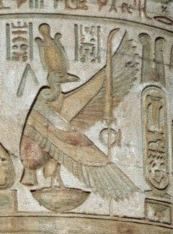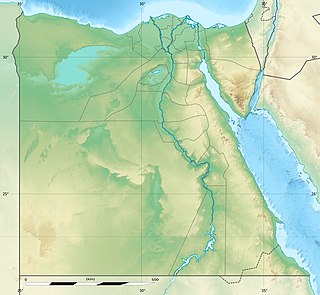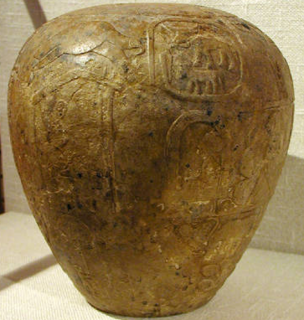
Horus is one of the most significant ancient Egyptian deities. He was worshipped from at least the late prehistoric Egypt until the Ptolemaic Kingdom and Roman Egypt. Different forms of Horus are recorded in history and these are treated as distinct gods by Egyptologists. These various forms may possibly be different manifestations of the same multi-layered deity in which certain attributes or syncretic relationships are emphasized, not necessarily in opposition but complementary to one another, consistent with how the Ancient Egyptians viewed the multiple facets of reality. He was most often depicted as a falcon, most likely a lanner falcon or peregrine falcon, or as a man with a falcon head.

Nekhbet was an early predynastic local goddess in Egyptian mythology, who was the patron of the city of Nekheb. Ultimately, she became the patron of Upper Egypt and one of the two patron deities for all of Ancient Egypt when it was unified.

Khnum was one of the earliest-known Egyptian deities, originally the god of the source of the Nile. Since the annual flooding of the Nile brought with it silt and clay, and its water brought life to its surroundings, he was thought to be the creator of the bodies of human children, which he made at a potter's wheel, from clay, and placed in their mothers' uteruses. He later was described as having moulded the other deities, and he had the titles "Divine Potter" and "Lord of created things from himself".
The 36th century BC was a century which lasted from the year 3600 BC to 3501 BC.

Naqada is a town on the west bank of the Nile in Qena Governorate, Egypt. It was known in Egyptian as nbwt, which became Coptic Ⲉⲙⲃⲱ, which was borrowed as classical antiquity as Ombos. Its name derives from Egyptian nbw, meaning "gold", on account of the proximity of gold mines in the Eastern Desert.

Nekhen or Hierakonpolis was the religious and political capital of Upper Egypt at the end of prehistoric Egypt and probably also during the Early Dynastic Period.

Edfu is an Egyptian city, located on the west bank of the Nile River between Esna and Aswan, with a population of approximately sixty thousand people. For the ancient history of the city, see below. Edfu is the site of the Ptolemaic Temple of Horus and an ancient settlement, Tell Edfu. About 5 km (3.1 mi) north of Edfu are remains of ancient pyramids.

The Thebaid or Thebais was a region of ancient Egypt, which comprised the thirteen southernmost nomes of Upper Egypt, from Abydos to Aswan.

Esna (Egyptian Arabic: إسنا IPA: [ˈʔesnæ], Ancient Egyptian: jwny.t or tꜣ-snt; Coptic: ⲥⲛⲏSnē from tꜣ-snt; Koinē Greek: Λατόπολις Latópolis or πόλις Λάτων or Λάττων ; Latin: Lato, is a city of Egypt. It is located on the west bank of the Nile some 55 km south of Luxor. The town was formerly part of the modern Qena Governorate, but as of 9/12/2009, it was incorporated into the new Luxor Governorate.

John Garstang was a British archaeologist of the ancient Near East, especially Anatolia and the southern Levant. He was the younger brother of Professor Walter Garstang, FRS, a marine biologist and zoologist. Garstang is considered a pioneer in the development of scientific practices in archaeology as he kept detailed records of his excavations with extensive photographic records, which was a comparatively rare practice in early 20th-century archaeology

Faiyum is a city in Middle Egypt. Located 100 kilometres southwest of Cairo, in the Faiyum Oasis, it is the capital of the modern Faiyum Governorate. Originally called Shedet in Egyptian, the Greeks called it Koinē Greek: Κροκοδειλόπολις Krokodilópolis, the Romans Arsinoë. It is one of Egypt's oldest cities due to its strategic location.

Naqada III is the last phase of the Naqada culture of ancient Egyptian prehistory, dating approximately from 3200 to 3000 BC. It is the period during which the process of state formation, which had begun to take place in Naqada II, became highly visible, with named kings heading powerful polities. Naqada III is often referred to as Dynasty 0 or the Protodynastic Period to reflect the presence of kings at the head of influential states, although, in fact, the kings involved would not have been a part of a dynasty. They would more probably have been completely unrelated and very possibly in competition with each other. In this period, those kings' names were inscribed in the form of serekhs on a variety of surfaces including pottery and tombs.
Hieracon or Hierakon, also called Theracon, Egyptian pr nmty, was an ancient fortified city of Upper Egypt situated on the right bank of the Nile, now the site of the modern-day village of al-ʿAtawlah, Egypt. Here, in Roman times, was quartered the cohors prima of the Lusitanian auxiliaries. It stood nearly midway between the western extremity of the Ἀλαβαστρινὸν ὄρος or Alabstrine Mountains and the city of Asyut, latitude 27° 15′North.
Scorpion I was the first of two rulers of Upper Egypt with that name, during Naqada III. His name may refer to the scorpion goddess Serket, though evidence suggests Serket's rise in popularity to be in the Old Kingdom, bringing doubt to whether Scorpion actually took his name from her. He was one of the first rulers of ancient Egypt.

The Souls of Pe and Nekhen, mentioned first in the Pyramid Texts, refer to the ancestors of the ancient Egyptian kings. Nekhen was the Upper Egyptian centre of the worship of the god Horus, whose successors the Egyptian pharaohs were thought to be. Pe was a Lower Egyptian town, not known for its Horus worship, but Ra had awarded the town to Horus after his eye was injured in the struggle for the throne of Egypt.

The Narmer macehead is an ancient Egyptian decorative stone mace head. It was found in the “main deposit” in the temple area of the ancient Egyptian city of Nekhen (Hierakonpolis) by James Quibell in 1898. It is dated to the Early Dynastic Period reign of king Narmer whose serekh is engraved on it. The macehead is now kept at the Ashmolean Museum, Oxford.

Horemkhaef was an Ancient Egyptian local official who lived in the Second Intermediate Period. He had the titles first inspector of priests of Horus from Nekhen and overseer of fields. Therefore, he was most likely the main priest at the local temple at Nekhen, where Horus was worshipped.
Esna or ESNA may refer to:
James Olan Mills, also known as Jay Mills, is an American archaeologist primarily known for his work in paleopathology and the excavations at Nekhen (Hierakonpolis), the capital of Upper Egypt in the late 4th millennium BC, ancient Egypt's Protodynastic Period.















